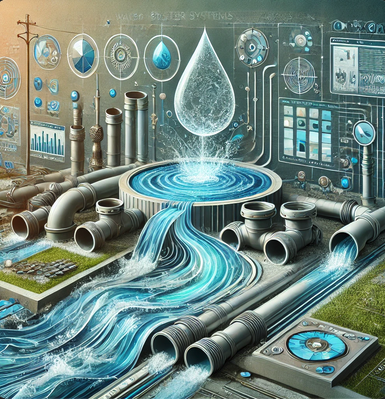1. Introduction#
Course Website
Readings#
Additional Readings
Videos#
Lesson Outline#
Course Overview
Types of Water Systems
Photo Essay
Software
Overview#
The title of the course is water systems design. The catalog description is:
CE 3372. Water Systems Design (3:3:0).Prerequesite: CE 33051, 33542.Hydraulic analysis and design of municipal water distribution, stormwater collection, and wastewater collection systems. Oral and written presentations. (Writing Intensive)
The general scope of the course is:
Examination of design guidance documents for drinking water distribution systems, a review of pipeline hydraulics, demand estimation, then a design project related to a drinking water distribution system.
The computer program EPANET is presented to provide a tool for the hydraulic modeling component of drinking water system design.
Examination of design guidance for stormwater collection systems, presents a review of open channel hydraulics (as related to storm sewers), capacity (hydrology) estimation, then a design project related to a stormwater collection system.
The computer program SWMM 5 is presented to provide a tool for the hydrologic/hydraulic modeling component of the stormwater collection system design.
Examination of design guidance for wastewater collection systems, then a design project related to a stormwater collection system.
The graded components of the course are:
Quizzes (administered on a learning management system); individual activity
Exercises (collected on a learning management system); individual activity
Exams (administered on a learning management system); individual activity
A design report (Three parts; collected on a learning management system); group activity
A design presentation (administered on a learning management system); group activity
Water Systems Definition(s)#
The course title is Water Systems Design, so a natural question is what is meant by a water system? In this course it refers to a water distribution system that conveys raw or treated water to customers, a storm water collection system that conveys storm water away from infrastructure to reduce flooding damages and activities of daily life inconvenience,and wastewater collection systems that convey wastewater to treatment facilities for eventual release of the water back into the environment (or intentional reuse).
Water systems can be classified into three main categories (Chin, 2006; Mays, 2011):
Water-control systems – to control the spatial and temporal distribution ofsurface runoff from rainfall events (drainage engineering). They can also servea use role if the captured rainwater is used later on for water supply (rainwaterharvesting).
Water-use system – to support human habitation and include water-treatmentsystems, water-distribution systems, wastewater-collection systems, and wastewater-treatment systems.
Environmental restoration system – to manage spatial and temporal distributionof water (quality and quantity) in support of non-human habitation.
Note
Cleveland, T. G. (2020) Water Systems Design Notes (Introduction Part 2) to accompany CE-3372, Department of Civil, Environmental, and Construction Engineering, Whitacre College of Engineering. is an extended version of this section
Water Control Systems#
Spatial and temporal distribution of surface runoff from rainfall events (drainage engineering)
Flood control
Storm water harvesting
Capacity is based on AREA served
Hydrologicaly dominated designs
Water Use Systems#
Spatial and temporal distribution in support of human habitation
Water supply/treatment/distribution
Waste water collection/treatment/discharge
Capacity is based on POPULATION served
Hydraulically dominated designs
Environmental Restoration Systems#
Systems to manage spatial and temporal distribution in support of non-human habitation
Create “desirable” conditions
“Desirable” <= Policy <= Value Judgment
Water System Photo Essay#
This brief photo essay is adapted from
“Historical Urban Water Systems” by Dr. Robert Pitt, Department of Civil and Environmental Engineering, University of Alabama, Tuscaloosa, AL 35487 http://54.243.252.9/ce-3372-webroot/3-Readings/water-system-photo-tour/water-system-photo-tour.pdf
As we proceed through the tour, using the general definitions above, decide whether the picture represents a water control, water use, or environmental restoration system.
Note
Cleveland, T. G. (2020) Water Systems Design Notes (Introduction Part 3) to accompany CE-3372, Department of Civil, Environmental, and Construction Engineering, Whitacre College of Engineering. is an extended version of the photo essay, with URLs to notable water systems worldwide.
Course Specific Software#
In this course we will use EPANET pipe network simulator software with the EPA supplied GUI, and SWMM 5+ drainage network simulator software with the EPA supplied GUI.
The remainder of the lesson demonstrates the installation of these tools:
Installing EPANET#
EPANET as supplied by https://www.epa.gov/water-research/epanet also includes a graphical user interface (GUI) that will allow one to quickly build network simulation models, run them, and present results. The GUI runs on Windows machines using Intel/AMD hardware. It can be made to run on other operating systems and architectures, but not easily.
Follow the guidelines on the https://www.epa.gov/water-research/epanet or watch https://www.youtube.com/watch?v=HoZC4FPBQzI
You can also examine https://epanet22.readthedocs.io/en/latest/2_quickstart.html
EPANET with the GUI runs in the Windows environment and expects the underlying machine to be an x86-64 chipset. Generally this means an Intel or AMD-based machine.
Warning
(circa 2020) If you have a Chromebook or Raspberry Pi, or Macintosh EPANET as deployed from the EPA won’t install directly. You can try WINE or other emulators but YOU ARE ON YOUR OWN!.
A viable alternative is an Amazon Web Services (AWS) Lightsail instance. The $12/month service will run both softwares, and works like ordinary Windows.
Installing SWMM#
Check your system#
SWMM with the GUI runs in the Windows environment and expects the underlying machine to be an x86-64 chipset. Generally this means an Intel- or AMD-based machine.
Warning
(circa 2020) If you have a Chromebook or Raspberry Pi, or Macintosh SWMM as deployed from the EPA won’t install directly. You can try WINE or other emulators but YOU ARE ON YOUR OWN!.
An alternative for these cases is an Amazon Web Services (AWS) Lightsail instance. The $12/month service will run both softwares, and works like ordinary Windows.
Download the installer#
URL to installer
Screen capture download
Run the installer#
Screen capture running the installer
Check the install#
To check the install, simply launch the program. If the GUI opens and renders the program is working. You can try a simple example if you wish.
Screen capture check
URL to SWMM by Example, load example 1
